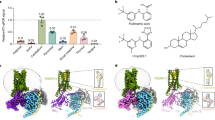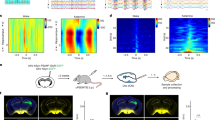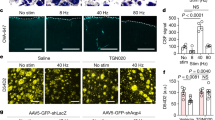Abstract
Salt taste in mammals can trigger two divergent behavioural responses. In general, concentrated saline solutions elicit robust behavioural aversion, whereas low concentrations of NaCl are typically attractive, particularly after sodium depletion1,2,3,4,5. Notably, the attractive salt pathway is selectively responsive to sodium and inhibited by amiloride, whereas the aversive one functions as a non-selective detector for a wide range of salts1,2,3,6,7,8,9. Because amiloride is a potent inhibitor of the epithelial sodium channel (ENaC), ENaC has been proposed to function as a component of the salt-taste-receptor system1,3,6,7,8,9,10,11,12,13,14. Previously, we showed that four of the five basic taste qualities—sweet, sour, bitter and umami—are mediated by separate taste-receptor cells (TRCs) each tuned to a single taste modality, and wired to elicit stereotypical behavioural responses5,15,16,17,18. Here we show that sodium sensing is also mediated by a dedicated population of TRCs. These taste cells express the epithelial sodium channel ENaC19,20, and mediate behavioural attraction to NaCl. We genetically engineered mice lacking ENaCα in TRCs, and produced animals exhibiting a complete loss of salt attraction and sodium taste responses. Together, these studies substantiate independent cellular substrates for all five basic taste qualities, and validate the essential role of ENaC for sodium taste in mice.
This is a preview of subscription content, access via your institution
Access options
Subscribe to this journal
Receive 51 print issues and online access
$199.00 per year
only $3.90 per issue
Buy this article
- Purchase on Springer Link
- Instant access to full article PDF
Prices may be subject to local taxes which are calculated during checkout




Similar content being viewed by others
References
Contreras, R. J. in Neural Mechanisms in Taste (ed. Cagan, R. H.) 119–145 (CRC, 1989)
Duncan, C. J. Salt preferences of birds and mammals. Physiol. Zool. 35, 120–132 (1962)
Lindemann, B. Receptors and transduction in taste. Nature 413, 219–225 (2001)
Beauchamp, G. K., Bertino, M., Burke, D. & Engelman, K. Experimental sodium depletion and salt taste in normal human volunteers. Am. J. Clin. Nutr. 51, 881–889 (1990)
Mueller, K. L. et al. The receptors and coding logic for bitter taste. Nature 434, 225–229 (2005)
Eylam, S. & Spector, A. C. Taste discrimination between NaCl and KCl is disrupted by amiloride in inbred mice with amiloride-insensitive chorda tympani nerves. Am. J. Physiol. Regul. Integr. Comp. Physiol. 288, R1361–R1368 (2005)
Halpern, B. P. Amiloride and vertebrate gustatory responses to NaCl. Neurosci. Biobehav. Rev. 23, 5–47 (1998)
Heck, G. L., Mierson, S. & DeSimone, J. A. Salt taste transduction occurs through an amiloride-sensitive sodium transport pathway. Science 223, 403–405 (1984)
Hettinger, T. P. & Frank, M. E. Specificity of amiloride inhibition of hamster taste responses. Brain Res. 513, 24–34 (1990)
Doolin, R. E. & Gilbertson, T. A. Distribution and characterization of functional amiloride-sensitive sodium channels in rat tongue. J. Gen. Physiol. 107, 545–554 (1996)
Kretz, O., Barbry, P., Bock, R. & Lindemann, B. Differential expression of RNA and protein of the three pore-forming subunits of the amiloride-sensitive epithelial sodium channel in taste buds of the rat. J. Histochem. Cytochem. 47, 51–64 (1999)
Schiffman, S. S., Lockhead, E. & Maes, F. W. Amiloride reduces the taste intensity of Na+ and Li+ salts and sweeteners. Proc. Natl Acad. Sci. USA 80, 6136–6140 (1983)
Vandenbeuch, A., Clapp, T. R. & Kinnamon, S. C. Amiloride-sensitive channels in type I fungiform taste cells in mouse. BMC Neurosci. 9, 1 (2008)
Yoshida, R. et al. NaCl responsive taste cells in the mouse fungiform taste buds. Neuroscience 159, 795–803 (2009)
Huang, A. L. et al. The cells and logic for mammalian sour taste detection. Nature 442, 934–938 (2006)
Yarmolinsky, D. A., Zuker, C. S. & Ryba, N. J. Common sense about taste: from mammals to insects. Cell 139, 234–244 (2009)
Zhang, Y. et al. Coding of sweet, bitter, and umami tastes: different receptor cells sharing similar signaling pathways. Cell 112, 293–301 (2003)
Zhao, G. Q. et al. The receptors for mammalian sweet and umami taste. Cell 115, 255–266 (2003)
Canessa, C. M. et al. Amiloride-sensitive epithelial Na+ channel is made of three homologous subunits. Nature 367, 463–467 (1994)
Hummler, E. & Beermann, F. Scnn1 sodium channel gene family in genetically engineered mice. J. Am. Soc. Nephrol. 11, S129–S134 (2000)
Strazzullo, P., D'Elia, L., Kandala, N. B. & Cappuccio, F. P. Salt intake, stroke, and cardiovascular disease: meta-analysis of prospective studies. BMJ 10.1136/bmj.b4567 (2009)
Ninomiya, Y. Reinnervation of cross-regenerated gustatory nerve fibers into amiloride-sensitive and amiloride-insensitive taste receptor cells. Proc. Natl Acad. Sci. USA 95, 5347–5350 (1998)
Oka, Y. et al. Odorant receptor map in the mouse olfactory bulb: in vivo sensitivity and specificity of receptor-defined glomeruli. Neuron 52, 857–869 (2006)
Hummler, E., Merillat, A. M., Rubera, I., Rossier, B. C. & Beermann, F. Conditional gene targeting of the Scnn1a (αENaC) gene locus. Genesis 32, 169–172 (2002)
Nelson, G. et al. An amino-acid taste receptor. Nature 416, 199–202 (2002)
Dethier, V. G. The taste of salt. Am. Sci. 65, 744–751 (1977)
Chandrashekar, J. et al. The taste of carbonation. Science 326, 443–445 (2009)
Frank, M. E. Taste-responsive neurons of the glossopharyngeal nerve of the rat. J. Neurophysiol. 65, 1452–1463 (1991)
Hellekant, G., Danilova, V. & Ninomiya, Y. Primate sense of taste: behavioral and single chorda tympani and glossopharyngeal nerve fiber recordings in the rhesus monkey, Macaca mulatta . J. Neurophysiol. 77, 978–993 (1997)
Hellekant, G. & Ninomiya, Y. Bitter taste in single chorda tympani taste fibers from chimpanzee. Physiol. Behav. 56, 1185–1188 (1994)
Acknowledgements
We thank W. Guo and A. Becker for generation and maintenance of mouse lines, and K. Scott and members of our laboratories for valuable comments. This research was supported in part by the intramural research program of the NIH, NIDCR (N.J.P.R.). C.S.Z. is an investigator of the Howard Hughes Medical Institute.
Author Contributions J.C. designed the study, carried out electrophysiological and expression studies, analysed data and wrote the paper; C.K. designed and carried out behavioural experiments and analysed expression in engineered and knockout mice; Y.O. designed and carried out calcium imaging experiments and analysed data; D.A.Y. carried out molecular studies and helped write the paper; E.H. provided essential reagents; N.J.P.R. and C.S.Z. designed the study, analysed data and wrote the paper.
Author information
Authors and Affiliations
Corresponding author
Ethics declarations
Competing interests
C.S.Z. is a scientific founder and scientific advisory board member of Senomyx.
Supplementary information
Supplementary Information
This file contains Supplementary Figures S1-S6 with Legends and Supplementary References. (PDF 2975 kb)
Rights and permissions
About this article
Cite this article
Chandrashekar, J., Kuhn, C., Oka, Y. et al. The cells and peripheral representation of sodium taste in mice. Nature 464, 297–301 (2010). https://doi.org/10.1038/nature08783
Received:
Accepted:
Published:
Issue Date:
DOI: https://doi.org/10.1038/nature08783
This article is cited by
-
The LRR receptor-like kinase ALR1 is a plant aluminum ion sensor
Cell Research (2024)
-
Comprehensive mapping of Epithelial Na+ channel α expression in the mouse brain
Brain Structure and Function (2024)
-
Effect of salivary gland removal on taste preference in mice
Pflügers Archiv - European Journal of Physiology (2024)
-
The proton channel OTOP1 is a sensor for the taste of ammonium chloride
Nature Communications (2023)
-
Identification Novel Salty-Enhancing Peptides from Sea Cucumber Collagen: AlphaFold2 Modeling and Molecular Simulation
Food and Bioprocess Technology (2023)
Comments
By submitting a comment you agree to abide by our Terms and Community Guidelines. If you find something abusive or that does not comply with our terms or guidelines please flag it as inappropriate.



